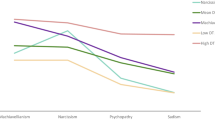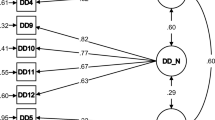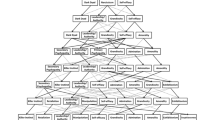Abstract
The Dark Triad represents a collection of three socially aversive traits, namely Machiavellianism, psychopathy, and narcissism. In this study, we examined the psychometric properties of the Italian translation of the Dark Triad Dirty Dozen (DTDD) in a sample of 799 adults, and we explored the associations among Dark Triad traits, theory of mind, empathy, and alexithymia. The DTDD showed a good internal consistency and a bifactor structure including a three-factor non-hierarchical model and a global, second-order factor with all of the DTDD items loading on it. The DTDD traits were positively associated with alexithymia and negatively associated with theory of mind and empathy. Also, results of regression analyses showed that difficulty identifying feelings and a reduced emotional reactivity were significant predictors of the Dark Triad traits. Our findings support the validity and reliability of the Italian translation of the DTDD, and suggest that individuals with high levels of Dark Triad traits may have difficulties in understanding and processing their own rather than other people’s emotional states.

Similar content being viewed by others
References
Ali, F., Amorim, I. S., & Chamorro-Premuzic, T. (2009). Empathy deficits and trait emotional intelligence in psychopathy and Machiavellianism. Personality and Individual Differences, 47(7), 758–762.
Austin, E. J., Farrelly, D., Black, C., & Moore, H. (2007). Emotional intelligence, Machiavellianism, and emotional manipulation: Does EI have a dark side? Personality and Individual Differences, 43(1), 179–189.
Bagby, R. M., Parker, J. D. A., & Taylor, G. J. (1994a). The twenty-item Toronto alexithymia scale-I. Item selection and cross-validation of the factor structure. Journal of Psychosomatic Research, 38(1), 23–32.
Bagby, R. M., Taylor, G. J., & Parker, J. D. (1994b). The twenty-item Toronto alexithymia scale-II. Convergent, discriminant, and concurrent validity. Journal of Psychosomatic Research, 38(1), 33–40.
Baron-Cohen, S. (2012). The science of evil: On empathy and the origins of cruelty. New York: Basic Books.
Baron-Cohen, S., Leslie, A. M., & Frith, U. (1985). Does the autistic child have a "theory of mind"? Cognition, 21(1), 37–46.
Baron-Cohen, S., Wheelwright, S., Hill, J., Roste, Y., & Plumb, I. (2001). The “reading the mind in the eyes” test revised version: A study with normal adults, and adults with Asperger syndrome or high-functioning autism. Child Psychology and Psychiatry, 42(2), 241–251.
Baskin-Sommers, A., Krusemark, E., & Ronningstam, E. (2014). Empathy in narcissistic personality disorder: From clinical and empirical perspectives. Personality Disorders, 5(3), 323–333.
Blackburn, R., & Coid, J. W. (1998). Psychopathy and dimensions of personality disorder in violent offenders. Personality and Individual Differences, 25(1), 129–145.
Bressi, C., Taylor, G. J., Parker, J. D. A., Brambilla, V., Aguglia, E., Allegranti, I., (...), & Invernizzi, G. (1996). Cross validation of the factor structure of the twenty-items Toronto alexithymia scale: An Italian multicenter study. Journal of Psychosomatic Research, 41(6), 551–559.
Briggs, S. R., & Cheek, J. M. (1986). The role of factor analysis in the development and evaluation of personality scales. Journal of Personality, 54(1), 106–148.
Brislin, R. W. (1970). Back-translation for cross-cultural research. Journal of Cross-Cultural Psychology, 1(3), 185–216.
Bushman, B. J., & Baumeister, R. F. (1998). Threatened egotism, narcissism, self-esteem, and direct and displaced aggression: Does self-love or self-hate lead to violence? Journal of Personality and Social Psychology, 75(1), 219–229.
Christie, R. (1970). Relationships between Machiavellianism and measures of ability, opinion, and personality. In R. Christie & F. L. Geis (Eds.), Studies in Machiavellianism (pp. 35–52). New York: Academic Press.
Christie, R., & Geis, F. L. (1970). Studies in Machiavellianism. New York: Academic Press.
Cleckley, H. C. (1976). The mask of sanity (5th ed.). St. Louis: Mosby.
Cortina, J. M. (1993). What is coefficient alpha: An examination of theory and applications. Journal of Applied Psychology, 78(1), 98–104.
Czarna, A. Z., Jonason, P. K., Dufner, M., & Kossowska, M. (2016). The dirty dozen scale: Validation of a Polish version and extension of the nomological net. Frontiers in Psychology, 7, 445.
Fehr, B., Samson, D., & Paulhus, D. L. (1992). The construct of Machiavellianism: Twenty years later. In C. D. Spielberger & J. N. Butcher (Eds.), Advances in personality assessment (Vol. 9, pp. 77–116). Hillsdale: Erlbaum.
Fonagy, P., Gergely, G., Jurist, E., & Target, M. (2002). Affect regulation, mentalization and the development of the self. New York: Other Press.
Gunnthorsdottir, A., McCabe, K., & Smith, V. (2002). Using the Machiavellianism instrument to predict trustworthiness in a bargaining game. Journal of Economic Psychology, 23(1), 49–66.
Gustafson, S. B., & Ritzer, D. R. (1995). The dark side of normal: A psychopathy-linked pattern called aberrant self-promotion. European Journal of Personality, 9(3), 147–183.
Hare, R. D. (1991). The Hare psychopathy checklist-revised (PCL-R). Toronto: Multi-Health System.
Hare, R. D. (1999). Without conscience: The disturbing world of the psychopaths among us. New York: Guilford Press.
Hare, R. D., Williamson, S. E., & Harpur, T. J. (1988). Psychopathy and language. In T. E. Moffitt & S. A. Mednick (Eds.), Biological contributions to crime causation (pp. 68–92). Dordrecht: Martinus Nijhof Systems.
Hart, S. D., & Hare, R. D. (1997). Psychopathy: Assessment and association with criminal conduct. In D. Stoff, J. Breiling, & J. Maser (Eds.), Handbook of antisocial behavior (pp. 22–35). New York: Wiley & Sons.
Hooker, C. I., Verosky, S. C., Germine, L. T., Knight, R. T., & D’Esposito, M. (2008). Mentalizing about emotion and its relationship to empathy. Social Cognitive and Affective Neuroscience, 3(3), 204–217.
Jakobwitz, S., & Egan, V. (2006). The dark triad and normal personality traits. Personality and Individual Differences, 40(2), 331–339.
James, S., Kavanagh, P. S., Jonason, P. K., Chonodv, J. M., & Scrutton, H. E. (2014). The dark triad, schadenfreude, and sensational interests: Dark personalities, dark emotions, and dark behaviors. Personality and Individual Differences, 68, 211–216.
Jonason, P. K. (2015). The deceleration and increased cohesion of the dark triad traits over the life course. Psikhologicheskie Issledovaniya, 8, 43.
Jonason, P. K., Kaufman, S. B., Webster, G. D., & Geher, G. (2013a). What lies beneath the dark triad dirty dozen: Varied relations with the big five. Individual Differences Research, 11(2), 81–90.
Jonason, P. K., Kavanagh, P., Webster, G. D., & Fitzgerald, D. (2011a). Comparing the measured and latent dark triad: Are three better than one? Journal of Methods and Measurement in the Social Sciences, 2(1), 28–44.
Jonason, P. K., Koenig, B. L., & Tost, J. (2010). Living a fast life: The dark triad and life history theory. Human Nature, 21(4), 428–442.
Jonason, P. K., & Krause, L. (2013). The emotional deficits associated with the dark triad traits: Cognitive empathy, affective empathy, and alexithymia. Personality and Individual Differences, 55(5), 532–537.
Jonason, P. K., & Kroll, C. H. (2015). A multidimensional view of the relationship between empathy and the dark triad. Journal of Individual Differences, 36(3), 150–156.
Jonason, P. K., Li, N. P., & Czarna, A. (2013b). Quick and dirty: Some psychosocial costs associated with the dark triad in three countries. Evolutionary Psychology, 11(1), 172–185.
Jonason, P. K., Li, N. P., Webster, G. D., & Schmitt, D. P. (2009). The dark triad: Facilitating short-term mating in men. European Journal of Personality, 23(1), 5–18.
Jonason, P. K., & Luévano, V. X. (2013). Walking the thin line between efficiency and accuracy: Validity and structure of the dirty dozen. Personality and Individual Differences, 55(1), 76–81.
Jonason, P. K., Lyons, M., Bethell, E. J., & Ross, R. (2013c). Different routes to limited empathy in the sexes: Examining the links between the dark triad and empathy. Personality and Individual Differences, 54(5), 572–576.
Jonason, P. K., & McCain, J. (2012). Using the HEXACO model to test the validity of the dirty dozen measure of the dark triad. Personality and Individual Differences, 53(7), 935–938.
Jonason, P. K., Slomski, S., & Partyka, J. (2012b). The dark triad at work: How toxic employees get their way. Personality and Individual Differences, 52(3), 449–453.
Jonason, P. K., Strosser, G. L., Kroll, C. H., Duineveld, J. J., & Baruffi, S. A. (2015). Valuing myself over others: The dark triad traits and moral and social values. Personality and Individual Differences, 81, 102–106.
Jonason, P. K., Valentine, K. A., Li, N. P., & Harbeson, C. L. (2011b). Mate-selection and the dark triad: Facilitating a short-term mating strategy and creating a volatile environment. Personality and Individual Differences, 51(6), 759–763.
Jonason, P. K., & Webster, G. D. (2010). The dirty dozen: A concise measure of the dark triad. Psychological Assessment, 22(2), 420–432.
Jonason, P. K., Webster, G. W., Schmitt, D. P., Li, N. P., & Crysel, L. (2012a). The antihero in popular culture: A life history theory of the dark triad. Review of General Psychology, 16(2), 192–199.
Jones, D. N., & Paulhus, D. L. (2010). Different provocations trigger aggression in narcissists and psychopaths. Social Psychological and Personality Science, 1(1), 12–18.
Kline, R. B. (2016). Principles and practice of structural equation modeling (4th ed.). New York: Guilford Press.
Lane, R. D., Hsu, C. H., Locke, D. E. C., Ritenbaugh, C., & Stonnington, C. M. (2015). Role of theory of mind in emotional awareness and alexithymia: Implications for conceptualization and measurement. Consciousness and Cognition, 33, 398–405.
Lawrence, E. J., Shaw, P., Baker, D., Baron-Cohen, S., & David, A. S. (2004). Measuring empathy: Reliability and validity of the empathy quotient. Psychological Medicine, 34(5), 911–920.
Lee, K., & Ashton, M. C. (2005). Psychopathy, Machiavellianism, and narcissism in the five-factor model and the HEXACO model of personality structure. Personality and Individual Differences, 38(7), 1571–1582.
McHoskey, J. W. (1995). Narcissism and Machiavellianism. Psychological Reports, 77(3), 755–759.
McHoskey, J. W., Worzel, W., & Syzarto, C. (1995). Machiavellianism and psychopathy. Journal of Personality and Social Psychology, 74(1), 192–210.
Paulhus, D. L. (2014). Toward a taxonomy of dark personalities. Current Directions in Psychological Science, 23(6), 421–426.
Paulhus, D. L., & Williams, K. M. (2002). The dark triad of personality: Narcissism, Machiavellianism, and psychopathy. Journal of Research in Personality, 36(6), 556–563.
Petrides, K. V., Vernon, P. A., Schermer, J. A., & Veselka, L. (2011). Trait emotional intelligence and the dark triad traits of personality. Twin Research and Human Genetics, 14(1), 35–41.
Porter, S., Bhanwer, A., Woodworth, M., & Black, P. J. (2013). Soldiers of misfortune: An examination of the dark triad and the experience of schadenfreude. Personality and Individual Differences, 67, 64–68.
Preti, A., Vellante, M., Baron-Cohen, S., Zecca, G., Petretto, D. R., & Masala, C. (2011). The empathy quotient: A cross-cultural comparison of the Italian version. Cognitive Neuropsychiatry, 16(1), 50–70.
Raskin, R., & Terry, H. (1988). A principal components analysis of the narcissistic personality inventory and further evidence of its construct validity. Journal of Personality and Social Psychology, 54(5), 890–902.
Salekin, R. T., Debus, S. A., & Barker, E. D. (2010). Adolescent psychopathy and the five factor model: Domain and facet analysis. Journal of Psychopathology and Behavioral Assessment, 32(4), 501–514.
Schimmenti, A., Passanisi, A., & Caretti, V. (2014a). Interpersonal and affective traits of psychopathy in child sexual abusers: Evidence from a pilot study sample of Italian offenders. Journal of Child Sexual Abuse, 23(7), 853–860.
Schimmenti, A., Passanisi, A., Pace, U., Manzella, S., Di Carlo, G., & Caretti, V. (2014b). The relationship between attachment and psychopathy: A study with a sample of violent offenders. Current Psychology, 33(3), 256–270.
Tamura, A., Oshio, A., Tanaka, K., Masui, K., & Jonason, P. K. (2015). Development, reliability, and validity of the Japanese version of dark triad dirty dozen. Japanese Journal of Personality, 24(1), 26–37.
Taylor, G. J., Bagby, R. M., & Parker, J. D. A. (1997). Disorders of affect regulation: Alexithymia in medical and psychiatric illness. Cambridge: Cambridge University Press.
Vellante, M., Baron-Cohen, S., Melis, M., Marrone, M., Petretto, D. R., Masala, C., & Preti, A. (2013). The “reading the mind in the eyes” test: Systematic review of psychometric properties and a validation study in Italy. Cognitive Neuropsychiatry, 18(4), 326–354.
Wai, M., & Tiliopoulos, N. (2012). The affective and cognitive empathic nature of the dark triad of personality. Personality and Individual Differences, 52(7), 794–799.
Webster, G. D., & Jonason, P. K. (2013). Putting the “IRT” in “dirty”: Item response theory analyses of the dark triad dirty dozen - an efficient measure of narcissism, psychopathy, and Machiavellianism. Personality and Individual Differences, 54(2), 302–306.
Author information
Authors and Affiliations
Corresponding author
Ethics declarations
Ethical Approval
All procedures performed in studies involving human participants were in accordance with the ethical standards of the institutional and/or national research committee and with the 1964 Helsinki declaration and its later amendments or comparable ethical standards.
Informed Consent
Informed consent was obtained from all individual participants included in the study.
Conflict of Interest
On behalf of all authors, the corresponding author states that there is no conflict of interest.
Rights and permissions
About this article
Cite this article
Schimmenti, A., Jonason, P.K., Passanisi, A. et al. Exploring the Dark Side of Personality: Emotional Awareness, Empathy, and the Dark Triad Traits in an Italian Sample. Curr Psychol 38, 100–109 (2019). https://doi.org/10.1007/s12144-017-9588-6
Published:
Issue Date:
DOI: https://doi.org/10.1007/s12144-017-9588-6




